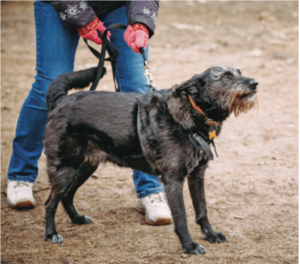
Although your dog seems to be fine with visitors to your home, you’ve noticed that she’s become increasingly aggressive toward people who approach the two of you when she’s on her leash. For example, the other day it was a nice sunny morning, you were walking your dog through your neighborhood when a new neighbor, out for her morning stroll, approached you.
“What a cute dog!” she exclaimed. Before you could stop her, she bent over and reached for your dog, only to have your beloved canine pal growl and lunge at or – shudder – perhaps even bite her human admirer. What just happened there? Was your dog protecting you?
It’s possible, but it’s far more likely that your dog was manifesting defensive fear-related aggression.
Is My Dog Protecting or Defending Me?
I see an average of a dozen clients a month who come to me because of concerns about their dogs’ aggressive behaviors. At some point during our consultation at least half of them suggest that their dog is trying to protect them. I suspect it might secretly make them feel better to think their dog is looking out for their best interests, even if it manifests as an undesirable behavior that risks the well-being of the dog as well as the person on the receiving end of the aggression. Sadly, dogs who bite people tend to lose their homes, if not their very lives.
I tell my clients that a far more likely explanation is that their dog is being defensively aggressive. She is probably a little cautious around (or even overtly fearful of) strangers.
Escape is usually the first behavior choice for a fearful dog, but if she’s on a leash and can’t retreat, she communicates in the only way she knows to tell the scary person to stay away. Growl. Lunge. Snap. Bite.
We often see this behavior emerge in dogs during adolescence, as they approach maturity. Most of my clients with these concerns have dogs who are from eight to 18 months of age. These are usually the dogs who were somewhat shy as a pup. Shy pups tend to shut down and suffer the attentions of the people who want to greet or comfort them. As they get a little older, they may respond with a growl instead of just shutting down.
Wise people back off when a dog growls. “Hey!” the dog learns. “That worked; I’m going to try that again!” The growling behavior is reinforced by success; the dog realizes that she can get people to leave her alone by growling at them, so she growls more when people approach. At some point when an approaching stranger doesn’t react quickly enough to growling, she escalates to a lunge. That works, too. Lunge, snap, and perhaps even bite are added to the behavioral repertoire.
Are Dogs Truly Protective?
Do dogs without training ever truly protect their humans? It does happen, but it’s rare. In many years of working with dogs, I’ve heard about this happening only once.
Years ago, one of my friends/co-workers at the Marin Humane Society adopted an outgoing, people-loving, medium-sized mixed-breed dog from our shelter, Sparky, who had never dreamed of biting a human in his life. One evening as my friend was walking with Sparky, they were confronted by a mugger with a gun, who demanded my friend’s fanny pack, which contained her wallet. Sparky launched himself at the mugger and was shot as a result, but the mugger took off leaving my friend unharmed and in possession of her fanny pack and all her valuables therein. And Sparky recovered from his injuries and continued to be a friend to every other human he met for the rest of his life.
So, it can happen – but it’s unlikely that’s what your dog is doing.
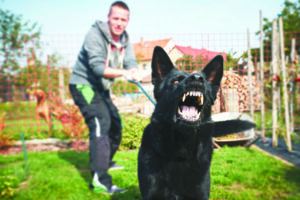
Photo Credits: Jaromir Chalabala / Dreamstime.com
Perhaps you want your dog to be protective. Some people hope that their canine family member will serve as some degree of protection, and sometimes, randomly adopted dogs often do. Many humans with ill intentions will steer clear of any person with a dog, not wanting to risk a possible encounter with an unfriendly canine. Homes where dogs live (especially vocal dogs) are less likely to be burgled for the same reason. That’s different, however, from the dog who is purposely trained or encouraged to be aggressive toward threatening people.
Protection training is a very precise and careful process, starting with a dog who is exceptionally well-adjusted and well-socialized. You don’t want a dog who is driven by fear or suspicion making poor decisions about who to attack!
At the simplest level of protection training, dogs are simply taught to bark on cue. You can do this yourself. It doesn’t even have to be an aggressive bark – someone approaching you with evil intentions will be put off by a dog barking – they’re not likely to stop and try to analyze canine body language to determine if your dog really might bite them.
Your cue should be a word or phrase that doesn’t tip off the person but might be natural in the situation. It could be “What do you want?!” in a slightly alarmed tone of voice – something you might say to a suspicious person approaching you. Alternatively or additionally the cue to bark could be an even more subtle signal that your dog would notice but the other person probably would not, such as a fake sneeze, an upward tug on the leash (assuming you don’t normally tug up on your dog’s leash), or whatever makes sense to you. Once you’ve taught your dog to bark on cue, simply cue her to bark if someone is approaching who makes you uncomfortable.
I would suggest you stop there. The mainstream dog-loving population doesn’t really need a dog to be a fang-flashing deadly weapon, and the responsibility and liability of caring for a protection-trained dog is huge. If you do have a legitimate need for a trained protection dog, be sure to seek out the services of a reputable protection-dog trainer. We recommend force-free training, but if a trainer is not force-free, at a minimum, we’d hope the candidate trainer honestly and assiduously follows the least invasive, minimally aversive (“LIMA”) principles espoused by professional organizations such as the Association for Professional Dog Trainers and the Certification Council for Professional Dog Trainers.
DEFENSIVE AGGRESSION
Assuming your dog is being defensively aggressive, not really protecting you, what can you do about it?
You can manage her behavior, of course, by keeping her safe at home where she’s not going to be approached by someone who makes her uncomfortable. However, a lot of people adopt dogs because they enjoy taking them for walks. If this is true for you, you can manage by stopping anyone from approaching and trying to pet her, especially when you are walking her on leash.
You need to be brusque and assertive for this to work. By the time you politely say, “Please don’t approach my dog, she’s really not comfortable with strangers,” she could have already bitten the rapidly advancing dog-lover. Instead, hold your hand up, chest high and palm forward in the universal “stop” signal, and say “Stop!” in a loud, assertive tone. Now you have time to explain why you don’t want them to pet your dog. Stick to your guns, even if you get the standard “But dogs love me!” assurance.
Of course, it’s even better if you can convince your dog she doesn’t have to be fearful of people she doesn’t know. Classical counter-conditioning and desensitization is very useful here: Consistently pair the presence of strangers with very high-value treats (we use chicken – baked, boiled, or the unseasoned frozen chicken strips you can find in your grocer’s freezer) while keeping your dog far enough away that she’s aware of their presence but not overly concerned. Strangers make treats happen!
If she won’t take the treats, or if she’s growling, barking, or lunging, you are too close! Let her look, then feed her a treat. Look, treat. Look, treat. When she no longer seems concerned about the person, move slightly closer and repeat the procedure. Take your time. If you think you’re going too slow, slow down.
It can also be useful to use a facsimile of trainer Suzanne Clothier’s “Treat/Retreat” protocol.* This one is nice because you can employ the assistance of the dog-loving stranger and fulfill her desire to interact with your dog in a safe way way while you are also helping your dog become more comfortable with strangers.
What you don’t want to do is have the scary stranger feed your dogs treats from their hand. While this seems like a feasible version of counter-conditioning (strangers make treats happen), it often draws the dog too close to the person (because she really wants the treat) and then when the treat is gone, she looks up to see the scary stranger right in her face, and wham! The bite happens.
Another thing you don’t ever want to do is punish your dog for her defensive behavior: no verbal or physical corrections, no squirt bottles, no yanking on the leash, no bean bags. While punishment may stop the behavior in the moment, these aversive methods are very likely to increase your dog’s stress, defensiveness, and aggression in the future when people approach; now she has to worry about what you’re going to do as well as what the stranger may do. Our goal is to have her associate good stuff with strangers, not bad stuff. We want her to feel better about people approaching, not worse!
How to Play a Treat and Retreat Game
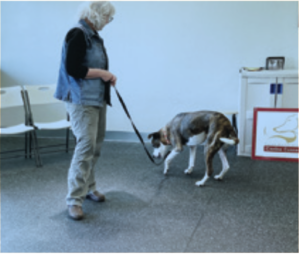
In order to play a Treat and Retreat game, you must have some tasty high-value treats, a dog leash (for safety, if you don’t trust your dog around people) volunteers, and a basic knowledge of canine signs of stress. If you want to play it safe, you can enlist the aid of a force-free dog behavior professional to show you how to do the initial work. Here’s how to carry out this behavior-altering game:
1. Arm your volunteers with a supply of kibble and a second bag of tasty, high-value, bite-sized treats.
2. Tell your volunteers to avoid making direct eye contact with your dog when they meet her, as many dogs find this threatening.
3. Upon meeting your dog, in your home or elsewhere, have your volunteer toss a high-value treat past the dog. This way your dog gets to retreat to get the treat.
4. Repeat many times with different people and at different times of the day, in different locations.
5. Once your dog is enjoying the procedure, it’s time to raise criteria. Have a volunteer toss the higher-value treat between herself and your dog (but very close to the dog) so the dog must move closer to the person. Then right afterward toss a lower-value treat (the kibble) past the dog.
6. Repeat with different people at different times of the day in different locations.
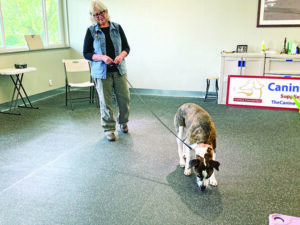
7. When your dog is clearly enjoying this game, you can further raise criteria. Have a volunteer gradually toss treats closer to herself so the dog comes closer (then toss one far away so the dog can retreat).
8. Repeat with different volunteers, different times of the day, in different locations until the dog is consistently more relaxed and starts taking more initiative in happily greeting people. As long as your dog is now happily approaching the volunteer with relaxed body language, soft eyes, and wagging tail, you can move to the next step. If not, go back to Step 6.
9. Eventually – and only as long as your dog is relaxed and comfortable with your volunteer –allow the person to hand-feed the higher-value treat to your dog, and right afterward, toss a lower-value treat (the kibble) past the dog.
It’s worth taking the time and making the effort to help your defensive dog become more comfortable with approaching strangers. The less stress in her life (and yours), the better the quality of life for both of you. The less stressed she is about encounters with strangers, the less likely an unfortunate incident will occur at some point in her future, and the more likely the two of you will be able to enjoy a long and happy life together.
- In a previous version of this article, trainer Suzanne Clothier’s Treat/Retreat protocol was mentioned without attribution to her. We regret the omission.


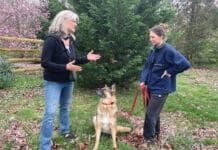



What I have always wondered is why people feel that their dogs need to like everyone and every dog they meet. Why do we have to label them? Most people do not like every person and every dog they like (and we always cannot put our finger on why a person rubs us the wrong way). So why should our dogs? Would it be nice if everyone and every dog got along? Probably but that is not real life. My dogs do not like strangers no matter who they are . And I am okay with that. I tell people who have to come to my home that they do not like strangers and I put the dogs back away from the people to keep everyone safe. And personally the more I meet people, the more I like my dogs.
Exactly! The more I learn about people the more I love being with dogs. Pure souls filled with the greatest unconditional love.
My former rescue is afraid of new people. I agree our dogs do t have to like everyone. I know I sure don’t!
I say the same thing often, we don’t like everyone, why should they?
We have two dogs in the house my daughter dog and mine if my daughter comes close to me my dog will go (attack) my daughter feet I give out to him and put him in his bed it hasn’t worked any suggestions would be very welcome thank you Kay
From my own experience with multiple dogs — I would suggest that your daughter take over some of the care and training of your dog.
Have your daughter come near you and talk to you, and THEN reward your dog, Let your daughter keep the distance your dog can cope with. Over time reduce the distance so your dog can sit at heel while she comes up and talks to you. The work for them more relaxes situations.
I would recommend Karen Overall’s “Protocols”. Both for myself and my clients I’d suggested going even more slowly than she recommends.
I’d also be wary of the way your daughter might behave around your dog, especially when you are not there.
PS Because in other circumstances I discovered that, when I was NOT immediately present, my (then) son-in-law was kicking my dogs/
Is he now ex-son-in-law?
YES. Thank goodness, The next and present one is a treasure 🙂
What would cause a dog to growl at strangers when being walked by one person, but not another?
See comment by “Marie”
I agree with most of this article, but I disagree that dogs don’t protect us. I think they totally do as ai have witnessed with my two dogs. It depends a bit on the breed, but we’re the ones who provide a shelter and food for them, so they do respect that and will protect us. Also they love us and sense very well the other person’s energy. I would say that if the reactions are different it could be because they feel more protective of one person vs the other. Also, maybe each person taught the dog something different. Dogs’ behavior is very different toward each person in the household: they know who they can whine with to get treats and who won’t accept that. So I believe this will translate into how they walk and behave with different people when outside.
My dog is the sweetest thing out in public or on a leash walking. She loves people and other dogs. However, when she is in my yard she is vocal about any pedestrians that walk by and I must make sure she is in the back yard for any deliveries as she is very serious about protecting her territory, I.E. the house and yard. They first thing she does at the dog park is go greet all of the people and then the dogs. These are all people and dogs she has never met before. Same on walks. But when she is in the yard it is a different story. This is not a fearful dog.
She is protecting I think. Letting the world know it’s her yard 🐶
Interesting article. I agree that dog guardians need to advocate for their sensitive dogs and prevent strangers from frightening them. It’s also a good idea, of course, to lessen the dog’s fear. The Treat/Retreat method invented by Suzanne Clothier works beautifully and empowers the dog to make his/her own choices and experience the results. It should be noted that Miller’s description here is not exactly the same as Clothier’s original Treat/Retreat (which I did not see acknowledged in the article). Clothier’s method requires more finesse than the short cut approach described here. Using treats to lure a fearful dog closer to people – whether the person is tossing or holding the treat – is not the same thing as allowing the dog to move freely and make the choice independently. Clothier’s Treat/Retreat method does not lure, it simply meets the dog where s/he is and allows a natural flow of interactions.
Please give credit to Suzanne Clothier for Treat Retreat. She is the gifted trainer that developed the tool to help reactive and “shy” dogs
NOT for my dogs, PLEASE!! Lost my heart dog to a strychnine bait. My dogs now do NOT take food from strangers!
I agree that most of the time dogs growl to get space for themselves, but I was a bit surprised that Suzanne Clothier was not credited with being the originator of this technique. The dog should not ever be put in a position where he “must move closer to the person.” You can find resources on how to correctly utilize this super valuable technique on Suzanne’s website.
Better yet, seek out a Certified Treat/Retreat Instructor who can help you with the intricate layers of sophistication that make this technique such a powerful tool. Thanks for crediting Suzanne Clothier as the creator of Treat/Retreat.
I am very disappointed in this article, and that Pat Miller and Whole Dog Journal have made the recommendations contained in this article. “Treat Retreat” has been well established by Suzanne Clothier, not as a way to get dogs to move closer to a stranger, but to truly counter condition a dog. As Temple Grandin mentioned in a Clothier workshop, the reason Treat Retreat works so well, is not because it tries to get a dog to come closer to a person, but because it puts the dog into a “seeking/searching/scenting/thinking state of mind. The goal of Treat Retreat (properly done as defined by Suzanne Clothier) is not to coax dogs to move closer to a stranger. It is to associate treats with a stranger at the distance the dog feels comfortable. This article is very concerning, because it completely misconstrues the entire concept of “Treat Retreat” and will put dogs into a state of conflict by having well intentioned volunteers “raise criteria” “so the dog MUST [capitalization added] move closer to the person.” The Treat Retreat protocol recommended in this article controverts the heart and training principles that have become well respected and established by Suzanne Clothier. Although I am disappointed that no credit given to Suzanne, it perhaps is fortunate that the credit was not given because the training concepts and principles in this article have been not only misinterpreted, but are laid out in a fashion that will allow mechanical interpretation (and mistakes) by well meaning volunteers rather than understanding the true core counter conditioning concepts. I suggest Whole Dog Journal editorial staff review Suzanne Clothier’s online Treat Retreat course and consider having Suzanne write an article about working with fearful dogs.
I would NEVER NEVER let a stranger throw treats on the ground for my dogs. it is asking for trouble.
First, Pat Miller should give credit to Suzanne Clothier who developed the Treat/Retreat protocol. Second, Ms. Miller’s description is inaccurate as to same. Perhaps she should go back to Suzanne’s original work and refresh her knowledge as to same before publishing this type of article.
I have found a slightly different approach to the rolling treats to be successful if the dog is basically a happy playful dog but is nervous around strangers. I play Ready, Get It. In a happy voice, I tell the dog to Ready, Get It and toss the treat past the dog. I keep doing that but toss the treat in lots of different directions, all to or past the dog and as rapidly as possible. It’s a way of combining pairing me with good stuff, a predictable cue and play at the same time. It’s been working well for me in many cases.
Suzanne Clothier developed the protocol for Treat Retreat; her work should be referenced and cited. She has excellent materials on her website, including an excellent recorded webinar on Treat-Retreat for everyone and a Certification course for professionals looking to develop all the nuances possible from the technique. Treat-Retreat is powerful and nuanced. It teaches dogs skills that work to increase confidence. “respects the dog’s boundaries, arousal and abilities.” Treat-Retreats rests on the foundation of Suzanne’s Elemental Questions (also highly recommended) that include “How Is This For You?”
As mentioned above, we were remiss in failing to credit trainer Suzanne Clothier for developing (and trademarking) “Treat/Retreat” – a specific and complex protocol. To learn more about Clothier’s method and certification for this technique, see http://www.suzanneclothier.com. We regret the omission.
I appreciate Nancy Kerns’ response to the numerous comments by readers bringing up Suzanne Clothier as the person who developed Treat/Retreat. As someone taking Suzanne’s Treat/Retreat course, I have been struck by how difficult it can be for humans to imagine that leaving choice up to the dog can actually lead to a change in behavior. In Treat/Retreat, the treats are thrown either TO the dog or BEHIND the dog. They are never thrown closer to the person than the dog has chosen to be.
In our culture, we have learned that everything a dog does has to be controlled, with the decisions for the behavior left up to the person. This is the case regardless of techniques and philosophy. In Treat/Retreat, the decision is left up to the dog, thereby empowering them to start thinking through, and noticing, that they are safe and in control. It is a powerful and profound thing to watch, when a fearful dog realizes they are in control and can calmly and mindfully make the decision to move away.